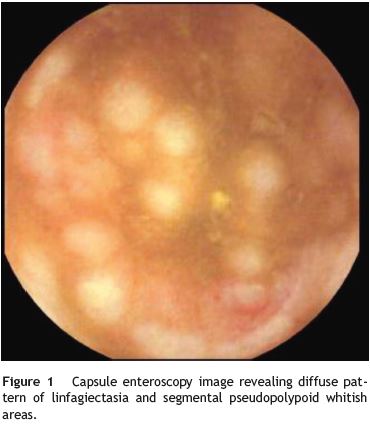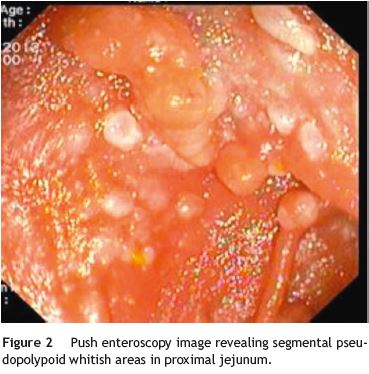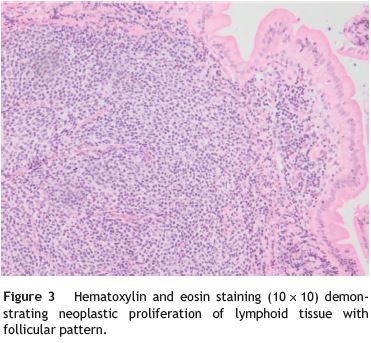Serviços Personalizados
Journal
Artigo
Indicadores
Links relacionados
Compartilhar
Jornal Português de Gastrenterologia
versão impressa ISSN 0872-8178
J Port Gastrenterol. vol.21 no.3 Lisboa jun. 2014
https://doi.org/10.1016/j.jpg.2013.10.001
ENDOSCOPIC SPOT
Chronic abdominal pain with a difficult diagnosis
Um diagnóstico difícil de dor abdominal
Ana Maria Oliveira∗, Catarina Rodrigues, Liliana Santos, Alexandra Martins, João Ramos de Deus
Serviço de Gastrenterologia, Hospital Prof. Doutor Fernando Fonseca, Amadora, Portugal
*Corresponding author
A 74-year-old man attended our gastroenterology outpatient clinic with hipogastric aching pain for the past 5 years associated with recent worsening of chronic constipation. Physical examination as well as abdomino-pelvic ultrasound and colonoscopy was unremarkable.
Anti-antispasmodics and dietary measures did not improve the clinical condition. For this reason, we performed an abdomino-pelvic computed tomography (CT) scan which showed thickening of the terminal ileum.
The patient repeated colonoscopy with ileoscopy and regular hogback in the terminal ileum was observed that could not be overcome, lined by normal mucosa. It was biopsed, but histologic examination was normal.
The entero-resonance was suggestive of nonspecific mesenteritis, but did not reveal changes in small bowel. Serologies to Crohns disease and celiac disease were negative.
A video capsule enteroscopy was performed which revealed diffuse pattern of linfagiectasia and segmental pseudopolypoid whitish areas in jejunum and ileum (Fig. 1).

Through push enteroscopy (Fig. 2) with a Pediatric colonoscope, biopsies of proximal jejunum were taken.

Microscopic examination demonstrated neoplastic proliferation of lymphoid tissue with follicular pattern (Fig. 3).

The tumor cells were positive for CD20, CD10, BCL2, BCL6 and negative for CD3, CD5, CD23, and 5 blasts per high power field were observed. Based on these findings, a diagnosis of follicular lymphoma grade 1 was established.
After performing thoraco-abdomino-pelvic CT scan and osteomedullar biopsy, the disease was classified at stage II2 (Lugano classification).
He was referred to the Hematology Department, who adopted the watch and wait strategy. He is now in the sixth month of surveillance, without clinical worsening.
Primary extranodal follicular lymphoma (FL) is uncommon, constituting less than 7% of GI tract lymphomas.1
The most common site in the small intestine is the duodenum followed by the ileum.2
FL of the gastrointestinal tract most frequently occurs in middle-aged adults with a slight female predominance (2:1).3
The clinical presentation of small intestinal lymphoma is non-specific and the patients may have symptoms such as abdominal pain, nausea, vomiting, and weight loss.4 Due to a lack of characteristic symptoms and a low incidence rate, primary intestinal lymphoma is easily misdiagnosed until serious complications occur, such as perforation and ileus.5
The introduction of capsule endoscopy represented a major advance in the diagnosis of small bowel diseases, such as in the presented case.
FL is localized in the bowel and regional lymph nodes in the vast majority of cases. The prognosis is favorable even when the disease is disseminated.3
References
1. Damaj G, Verkarre V, Delmer A, Solal-Celigny P, Yakoub-Agha I, Cellier C, et al. Primary follicular lymphoma of the gastrointestinal tract: a study of 25 cases and a literature review. Ann Oncol. 2003;14:623-9. [ Links ]
2. Bautista-Quach MA, Ake CD, Chen M, Wang J. Gastrointestinal lymphomas: morphology, immunophenotype and molecular features. J Gastrointest Oncol. 2012;3:209-25. [ Links ]
3. Misdraji J, Harris NL, Hasserjian RP, Lauwers GY, Ferry JA. Primary follicular lymphoma of the gastrointestinal tract. Am J Surg Pathol. 2011;35:1255-63. [ Links ]
4. Ghimire P, Wu G, Zhu L. Primary gastrointestinal lymphoma. Gastroenterology. 2011;17:697-707. [ Links ]
5. Wang GB, Xu GL, Luo GY, Shan HB, Li Y, Gao XY, et al. Primary intestinal non-Hodgkins lymphoma: a clinicopathologic analysis of 81 patients. World J Gastroenterol. 2011;17:4625-31. [ Links ]
Ethical disclosures
Protection of human and animal subjects. The authors declare that no experiments were performed on humans or animals for this study.
Confidentiality of data. The authors declare that they have followed the protocols of their work center on the publication of patient data and that all the patients included in the study received sufficient information and gave their written informed consent to participate in the study.
Right to privacy and informed consent. The authors have obtained the written informed consent of the patients or subjects mentioned in the article. The corresponding author is in possession of this document.
Conflicts of interest
The authors have no conflicts of interest to declare.
*Corresponding author
E-mail address: anaoliveira.fml@gmail.com (A.M. Oliveira).
Received 7 August 2013; accepted 28 October 2013













